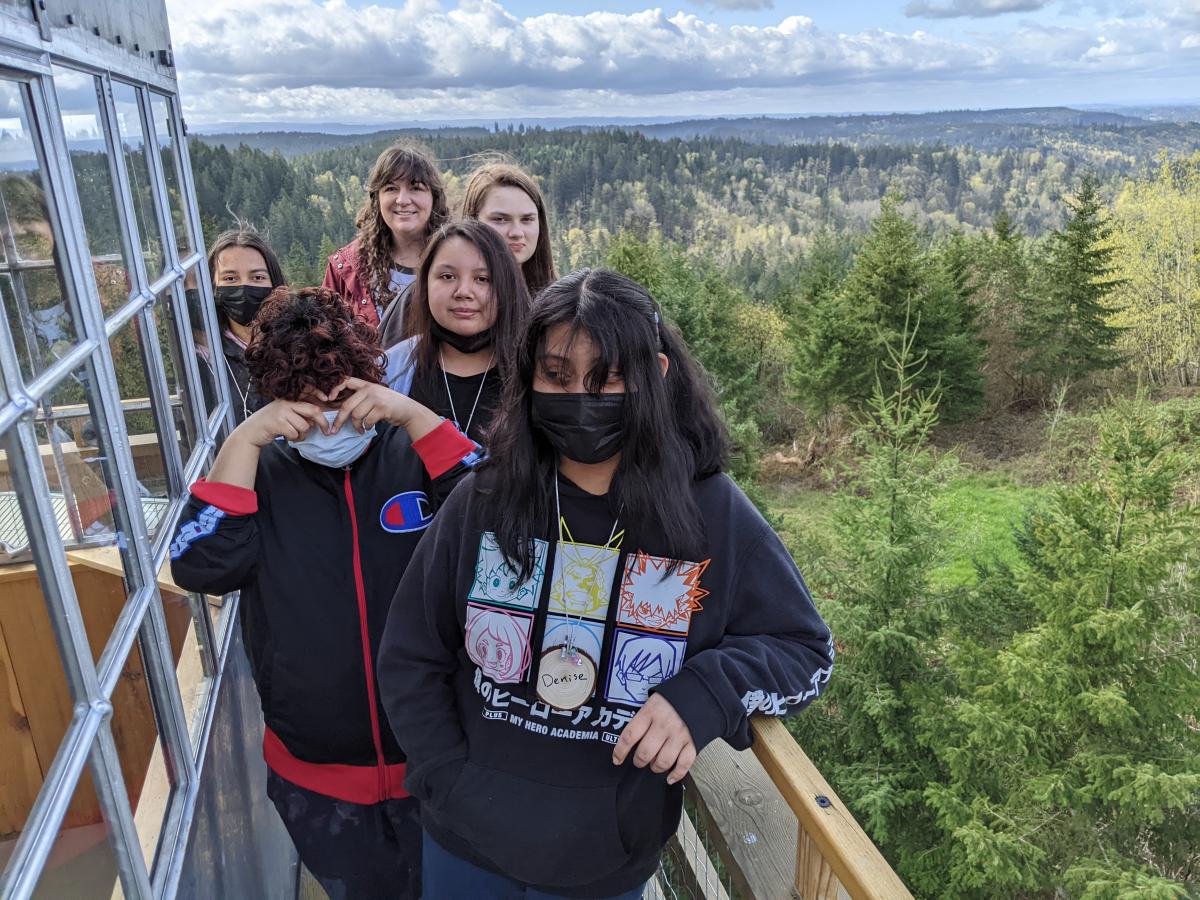District Office
20256 Grim Road NE
Aurora, Oregon 97002
Phone number: (503) 678‑7100
20256 Grim Road NE
Aurora, OR 97002
Phone: (503) 678-7100
Fax: (503) 386-4659

By Jillian Daley
Why are people so excited about outdoor education? It’s not like students often become more interested in school and see their grades go up — except that research shows that regular educational visits in the great outdoors can do exactly that!
Because of the value of learning in the open air, North Marion Middle School has traditionally had an overnight Outdoor School (ODS) adventure for sixth-graders, but the annual program was canceled two years in a row during the virtual- and hybrid-learning days of the pandemic. To make it up to students, ODS Adviser Amanda Kahle created the Outdoor Learning Experience (OLE), a series of three day trips in three weeks. OLE concludes this week on April 15, providing an opportunity to learn in the great outdoors to students in all three grade levels.
Just like in ODS, students who have been participating in OLE are wearing wood cookies and soaking up lessons in the natural sciences. Only, it wasn’t overnight in a cabin, instead at Hopkins Demonstration Forest in Oregon City, Oregon Zoo in Southwest Portland, and Bonneville Dam in the Columbia River Gorge. Wherever, however, it was, students were thrilled with a field trip.
“It’s more hands-on instead of out of a book,” eighth-grader Addison Jakobson said. “Personally, I learn better hands-on than out of a book, so it’s better for me, but everyone is different.”
This past Friday, April 8, eighth-graders including Jakobson went to Hopkins, a 140-acre woodland property with four miles of hiking trails that was established in 1991 and is now owned by the nonprofit Forests Forever Inc. (FFI). Students hiked, studied trees and other plants, learned about animal scat, and delved into the teeming life in and around ponds. Also, because volunteers from Oregon State Extension Service and FFI were present, students could climb a fire lookout originally built in 1954 to protect the forest from flames.
The tower, called the Clatskanie Mountain Fire Lookout, has since been reinforced and encased in safety fencing. At 65 feet high, it offered a bird’s eye view of the landscape — but was a bit intimidating to ascend.
Before embarking on a many-staired journey up, Anette Duran and Denise Hernandez said the lookout tower was one of the most exciting things for them.
“I’ve never been that high up,” Hernandez said.
Having a less enthusiastic response was her classmate, Paola Hernandez (no relation).
“I shouldn’t have gone!” said Paola Hernandez, taking a pause halfway up.
Counselor Kelsey Brown gave her encouragement, telling her she was brave. She was. With Brown’s help and her friends’, Paola Hernandez made it to the top and laughed with the others on the way down.
Atop the tower sits a cabin sits a cabin containing historical devices that include a lantern, communication radio, and Osborne Fire Finder, created by a U.S. Forest Service employee from Portland. The fire finder looks like a round map, with a rotating board and intersecting lines that allow a user to find a location on that map.
At Hopkins, volunteers were on hand to offer the students instruction, including FFI Board of Directors member Ben Smith, who waited for students on the wooden catwalk encircling the 7-foot cabin at the top.
Smith, Regional Fiber Supply Manager at WestRock Company (with 50,000 employees all over the world), asked the students “How do you think they find out where fires are now?”
Student Cheyenne Younce replied, “satellite.”
Then Smith told them the Osborn is how people once located fires. He encouraged them to see if they could find their hometown and Brown’s small group of charges peered at the Osborn, attempting to find sites all over the area.
Brown then led Younce, the Hernandezes, Duran, and Valeria Daza on a hike to one of the educational stations. It was the second hike Daza had ever been on, and the young student looked around, quietly appreciating the beauty, such as the sunlight filtering through the boughs of trees.
In another group, Rayahnna Saucedo and Gio Velazquez couldn’t wait to see any animals they could among those trees.
Velazquez said that they may even find a deadly spider.
“That’s something you should learn about,” he said.
(The most harmful spider in Oregon is the western black widow. While it is uncommon for its bite to be fatal, if you’ve been bitten, seek medical attention.)
Saucedo agreed that wildlife inspires awe, but she was mostly glad to just be in nature.
“We’re outside, we’re not in a classroom,” she said, happily.
Yet, there they were, still learning, and with a light of joy in their eyes.
To share story ideas, email Communications Specialist Jillian Daley at jillian.daley@nmarion.k12.or.us.